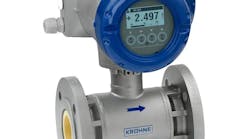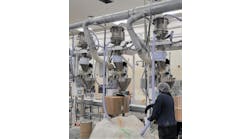AI Transforms Sustainability, Topples Silos
head of product and portfolio marketing, Augury
No longer a warm-fuzzy concept, sustainability is increasingly becoming as good for the bottom line as it is for the environment. To explain how AI-driven solutions that target machine and process health can help with strategy and results, Chemical Processing spoke with James Newman, head of product and portfolio marketing with Augury, a production health solutions provider that combines advanced sensors with AI capabilities and human expertise.
Q: What are the unique challenges that chemical manufacturers face in terms of sustainability efforts?
A: Chemical processing, by its very nature, is energy intensive and the processes themselves are full of chemicals. But the biggest sustainability challenges center around the necessary cultural mind shift.
Most companies don't know what strategies will make the biggest impact on their investments. The zero-sum game of profitability versus the planet versus people has been a problem for well over 100 years now. It puts us in a mindset where you can optimize for something, but you can't optimize for everything, where you have to make trade-offs with all kinds of downsides.
Q: What has changed in the past five years in terms of outlooks and goals for sustainability?
A: Almost two decades ago the phrase "carbon footprint" came into being. To be quite honest, it was an attempt to shift the concept of sustainability and accountability away from corporations and toward the general public. Today, investors, regulators, the general public, and even employees know better. There's a lot more pressure applied to every level of an organization to be more sustainable. A company’s ability to greenwash their activities is going to come under a lot more scrutiny. But the good news is most companies have fairly robust and well-communicated strategies and policies for sustainability efforts.
Plant Services magazine just published a report, “The ESG paradox: policy vs. practice.” And in that report, focusing specifically on the chemical industry, the research shows that most companies have clearly defined ESG policies in place. But at the same time, they haven’t permeated through the organization in a meaningful and tangible way. To improve sustainability, chemical manufacturers have to be able to translate policies and procedures into goals and objectives.
Q: Are there examples of technology available today to help translate to true sustainability?
A: What’s really changing the dynamic is our ability to use AI and other advanced analytics solutions to transform the way we manage the manufacturing process, top to bottom.
For example, continuous asset monitoring isn't really a new concept. What is new, however, is having prescriptive, real-time asset insights that do two things: prevent machine failure and understand suboptimal operation.
Machines that run inefficiently consume a lot more energy. When you’re alerted to this you can make better decisions on how to maintain them to avoid downtime, but also to ensure they do their job with the least amount of energy necessary.
On the process side, it's always been a single-dimensional challenge: Do you have your team pick the best operating envelope for quality, or do you pick throughput or energy emissions? Those three things are not necessarily all lined up, and in the traditional methods, you can pick one of them and maybe get lucky and do something about one of the others.
Today, we have AI-driven solutions that enable you to do dynamic and multidimensional process optimization, which means you now get to set your objectives for all those factors at one time and find the right operating envelope that lets you get as close to perfect as you can and continually update that as your business objectives and your external conditions change.
Q: These goals need to pay off for many different areas: companies, shareholders, the environment, and the employees. What's different today?
A: If you look at our newest generation of workers, they're highly environmentally and socially conscious, and they want to work with companies that have similar goals and objectives.
Sustainability is not a new topic. What's different, however, is sustainability allows them to do what they should do to make their assets more profitable, make their production lines better, and improve quality. All those things are now embedded inside sustainability objectives.
Most sustainability efforts today are lagging indicators. "Oh, I have burned this much energy, and I'll look and see if there's a way I can change that next time." What we're able to do now is say, "I am burning too much energy. What adjustment can I make right now to bring that down without sacrificing my other objectives?" That's the big change we're talking about here.
With AI, sustainability becomes part of the chemical processing formula.
Q: How do you get plant managers and maintenance staff to grasp these KPIs and goals?
A: People work toward what they're measured against. If I have a goal in my production line to reduce energy emissions by 10%, and that's part of my performance metric, I'll pay a lot more attention to that than to a vague corporate goal of dropping energy emissions by 10%.
We need to have real, tangible goals in place that are measurable and part of what you do every day. The second half of that is to deploy technologies and solutions that help people achieve it.
Q: For manufacturers using predictive maintenance, how do they use the productivity and efficiency gains to lead to sustainability gains?
A: Machines that run correctly use less energy. But what if you can't see that? You need solutions that show you when a machine has an imbalance or when there's structural looseness or when there's bearing wear or friction rising in the system. If you have to fight friction, you use more energy. Seeing what your assets are doing lets you make a tangible impact.
The National Institute of Standards and Technology did a study several years ago that found unplanned downtime resulted in $3.3 billion of waste. Think about your process. You have lots of inputs — chemicals, energy, water. Those are also potential waste streams. If you have a defect, then all of that stuff you put in is now lost, including the energy to generate the product, which has now failed.
Q: Sustainability focuses on long-term outcomes, not the short-term gains. How can machine health help?
A: Machine health and process health work together to reduce energy consumption and waste streams. If I use less electricity today, I can report that. If I generate less waste today, that's a short-term thing.
Imagine a world where we can actually choose what we want to optimize for across a bunch of objectives. I have throughput, I have quality, I have energy emissions. What if you could put those into the same model and find out how to reach all of those objectives at the same time? And sustainability is baked in – those goals are an ingredient in the recipe when you make the cake.
Today, you can begin to do that. You can, every single day, look at your production line based on your constraints and your needs at the time. You're going to have periods where demand is higher or raw materials may be more expensive. You need to be able to account for all of those things to reach your objective — sustainability being one of them.
I don't believe sustainability should ever be a three-year objective. It should be, "What can I do today to make progress?"
Q: What about cross-functional collaboration, and where does machine health and process health enable that coordination?
A: Our vision for the world’s workforce is that machine health and process health completely transform the way teams work. Instead of working in silos with separate goals and objectives, they can see shared objectives and targets, which include their sustainability goals. And this aligned view means we can ask very different questions than we ever could before.
Instead of saying, "How do I manage maintenance and how do I manage operations?" It's, "How do I manage my maintenance plan to optimize performance while at the same time maximize throughput and minimize our waste streams and our energy consumption, and how is my team going to achieve that today?"
Our goal is to rip out the ampersand between maintenance and operations. And these technologies, these solutions, allow us to do that — to tackle sustainability and other goals together.
I think it's a tremendous opportunity for chemical manufacturers to be a leader in this effort because they get a lot of scrutiny for their environmental and sustainability objectives just by the very nature of their processes. They have the opportunity now to leverage the right technologies with the right cultural mindset, with the right organizational objectives, to actually be the leaders in sustainability. They’ll do it by driving how manufacturing is done and how we empower people to actually be responsible for and contribute to sustainability every single day.
For more information, visit www.augury.com





